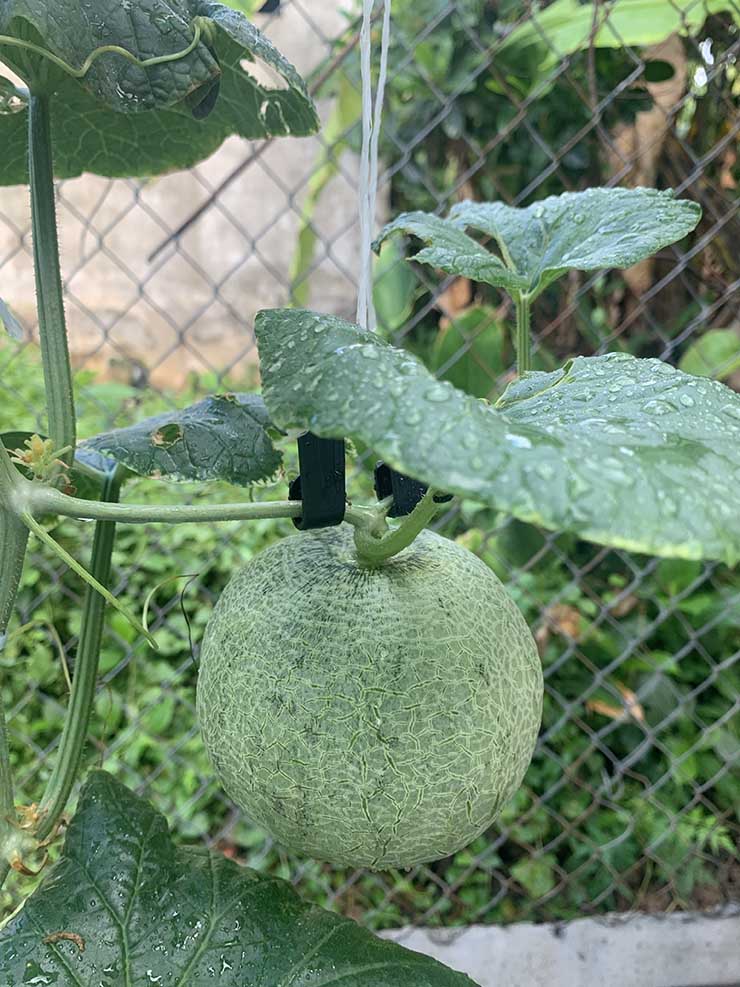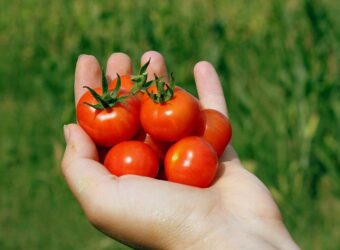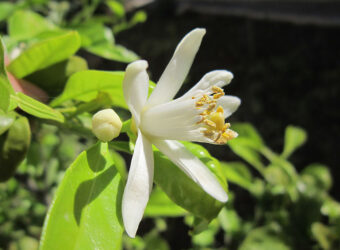Cantaloupes suffer from a lot of insect pests. The right companion plants can help that problem as well as others when planted around cantaloupe.
Why Does Cantaloupe Need Companion Plants?
Here are the ways companion plants help cantaloupe.
Repel Insects
Plants such as the Alliums and aromatic herbs repel insect pests with their scent. They protect cantaloupe from many pests, so you get healthier vines.
Bring Pest Predators
Many of the same herbs that repel insect pests attract predatory insects that eat insect pests on cantaloupe, especially aphids.
Increase Nutrients
Borage and beans increase the nutrients in the soil. Since cantaloupe vines are heavy feeders, the extra nutrients are welcome.
Break Up Heavy Soil
Carrots benefit cantaloupe by breaking up heavy soil. Grow them in the season before growing cantaloupes in that area.
Save Space
Quick crops like lettuce and radishes can be planted around the hills cantaloupe seeds are planted on. By the time the cantaloupe vines need the space, both crops are ready to harvest.
Benefit from Cantaloupe
Corn and pole beans have been planted with squash for centuries. You can substitute cantaloupe for the squash and keep the soil more moist and cooler than bare ground under those crops would be.
Top 15 Best Companion Plants for Cantaloupe
Here are the top fifteen companion plants for cantaloupe and what they do to help grow good crops of cantaloupe.
Alliums
Alliums, the family that includes garlic, onions, and chives, all have a strong smell that repels pests. Plant these in the rows next to the cantaloupe vines to protect them from thrips, aphids, and other pests.
Basil
Basil is another aromatic plant that repels thrips and aphids to protect cantaloupe. If you let the basil bloom, the blooms attract pollinators that will pollinate your cantaloupe and increase the number of melons you grow. Plant basil in adjacent rows or as a border around the cantaloupe patch.
Pole Beans
Beans fix nitrogen from the air around the roots. They fix more nitrogen than they use, leaving extra in the soil for other plants to use. As one of the three sisters, pole beans were planted with corn and squash in the arid Southwest by Indigenous people for centuries. You can substitute cantaloupes for squash. The corn is planted first. When it starts growing, pole beans are planted next to it, which grow up the corn. The squash is planted around the corn and keeps the ground cooler and moister than bare ground would be, while enjoying some shade in the late afternoon sun. The corn benefits from the extra nitrogen and the cooler, moister ground. Each plant benefits the other two. When the beans are done, cut the vines off at the soil level and leave the roots to decompose. The roots will add even more nitrogen to the soil.
Bee Balm
Bee balm is an herb used in traditional medicine. Pollinators love bee balm. When planted in a border around the cantaloupe patch, bee balm draws pollinators to help pollinate the cantaloupe and increase the number of melons. In addition, beneficial predatory insects like bee balm and will spread to eat aphids and other pests on cantaloupe. You can also plant bee balm in an adjacent row to provide these benefits to your cantaloupe.
Borage
Borage provides benefits while alive and after it dies. While alive, borage attracts pollinators and predatory insects. Both spread to the cantaloupe vines and help pollinate the flowers and eat pests. In addition, borage has lots of potassium and calcium in it. After it dies, till the borage under to allow it to decompose and deposit that potassium and calcium into the soil where cantaloupe can use it. Potassium helps trigger blooms, which lead to cantaloupes. Plant borage around the cantaloupe patch or in adjacent rows to attract beneficial insects. You can plant borage in the cantaloupe patch when you plant the cantaloupe. As the cantaloupe vines grow, they will choke out the borage and use the potassium as it decomposes.
Carrots
Carrots are good at breaking up heavy soil. You can plant them where you plan to grow cantaloupe vines later in the season, so the ground is easier for the cantaloupe roots to penetrate. Simply harvest the carrots when the vines need the room where they are planted. If growing carrots for seed, the flowers attract pollinators and predatory insects that will help the cantaloupe if grown in adjacent rows. Carrots usually flower the second year they are in the ground, so leave some in the ground over the winter to get the seeds.
Cilantro
Cilantro attracts pollinators and predatory insects to the garden. In addition, the smell repels aphids and some other insect pests that would otherwise eat the cantaloupe vines. Planting cilantro in the adjacent rows or in a border around the cantaloupe patch is the best way to use it as a companion to the cantaloupe.
Corn
As mentioned above, when talking about beans, corn is one of the three sisters in agriculture. You can plant it to hold pole beans and shade cantaloupe in a group, while the cantaloupe keeps the soil cooler and moister than bare ground. The beans contribute nitrogen to the other two plants.
Dill
Dill is loved by pollinators and predatory insects. Ladybugs love dill and aphids. Since aphids are a big problem for cantaloupe, planting dill around the cantaloupe or in the midst of the patch will help the cantaloupe. The vines will eventually choke out dill planted in the patch, but by then, the worst of the aphids will be done, and the dill can be harvested.
Lettuce
Cantaloupe seeds are usually planted on four- to six-inch-tall hills. You can plant lettuce around and between the hills to save space. The lettuce will be ready to harvest before the vines grow over the area, so you can get two crops in the same space. The lettuce will act as a living mulch to keep the soil cooler and moister than bare ground, making it easier for the vines when they grow there.
Marigolds
Marigolds repel many problem insects. They also house predatory insects such as hoverflies and parasitotic wasps. When the plants are tilled under after they are through growing, the chemicals in the marigolds repel root-knot nematodes. Planting marigolds where you plan to plant cantaloupe the next season can help get rid of the nematodes, so they do not bother the cantaloupe. Planting marigolds around the border of the cantaloupe patch or in adjacent rows will provide beneficial insects to help the cantaloupe.
Mint
Mint is another aromatic that repels aphids, squash bugs, flea beetles, and other troublesome insects. In addition, mint blooms attract both pollinators and predatory insects. However, mint is very invasive, so I never recommend planting mint in the ground. Use a large pot and place it at the head and foot of the row of cantaloupe vines. You can also set pots in the row, but will have to be sure and keep the cantaloupe vines from growing over them.
Nasturtium
Nasturtiums have a peppery scent that repels insects. They like partial shade in hot areas, so can be planted within the row of cantaloupe vines. They will provide some shade to the nasturtiums while the nasturtiums keep harmful insects away by masking the cantaloupe scent. Nasturtiums are edible, especially the flowers, which also have a peppery taste.
Oregano
Oregano is another aromatic that repels insects and attracts pollinators to the garden. However, oregano prefers dryer soil than cantaloupe does, so grow the oregano in pots that you place among the cantaloupes. The roots of the oregano will rot in the moist soil cantaloupe needs.
Radishes
Radishes are a fun crop because they only take a month to grow and be ready to eat. You can plant radishes in the area between hills in the cantaloupe patch when you plant the cantaloupe. By the time the vines start needing the space, the radishes are ready to harvest. This saves quite a bit of space in a small garden. As a bonus, the radishes repel many harmful insects with their scent.
Top 5 Worst Companion Plants for Cantaloupe
Some plants do not get along with cantaloupe. Here are five to avoid planting near your cantaloupe patch.
Cucumbers
Cucumbers are members of the same family as cantaloupe. They will cross-pollinate, and the melons that result are not good to eat. In addition, cucumbers have the same insect pests and diseases as cantaloupe. Planting them together increases the chance both crops will have problems.
Fennel
Fennel is an antisocial plant that secretes a chemical into the soil that stunts or kills other plants. It should be grown in a corner by itself or in a pot by itself. Fennel is good to eat, and swallowtail caterpillars love it but plant it away from any other plants.
Potatoes
Potatoes attract aphids. Aphids also love cantaloupe, so planting potatoes and cantaloupe together increases the chance both crops will suffer from an aphid invasion. Both potatoes and cantaloupe also take up a lot of space.
Squash
Squash, like cucumbers, is a relative of cantaloupe. Squash, including pumpkins, suffer from the same diseases and insect pests as cantaloupe. Planting them together lays out the welcome mat for pests and diseases to ruin both crops.
Watermelons
Watermelon, like squash and cucumbers, is related to cantaloupe. Plant them away from each other to stop pests from eating both crops.
In conclusion, cantaloupe gets most of the benefits from companion plants. Most of them repel insects that eat cantaloupe and attract predatory insects that eat pests. Cantaloupe does help keep the soil moist and cool when planted with corn and pole beans. Finally, other Cucurbits and plants like potatoes and fennel do not make good companions for cantaloupe






